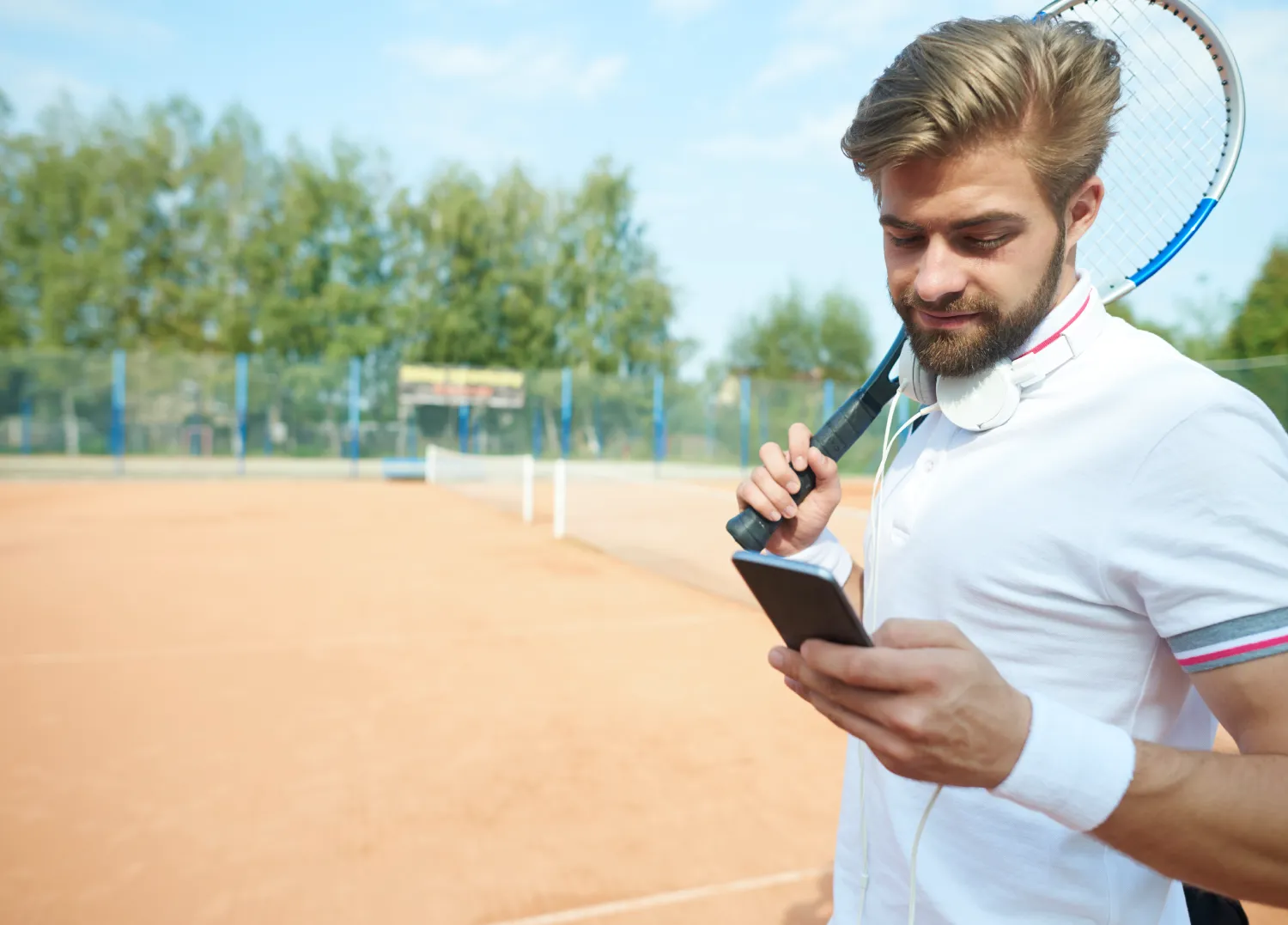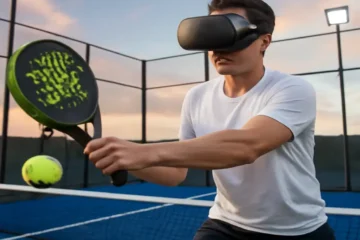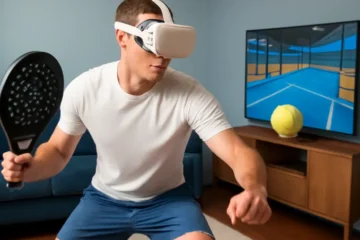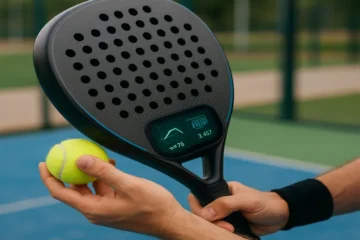In the world of padel, as in any sport, players are always looking for ways to enhance their performance, refine their skills, and outplay their opponents. Gone are the days of simply relying on repetitive drills and the eye of a coach to improve. Today, technology is stepping in to revolutionize how players of all levels train and compete, providing tools that give insight into every aspect of their game. From smart rackets that track swing speeds to AI-driven video analysis platforms that provide real-time feedback, technology is ushering in a new era of padel training.
The New Training Partner
We’ve all been there—on the padel court, trying to perfect a shot, but something just doesn’t feel right. Maybe your overhead smash isn’t as powerful as it used to be, or perhaps your footwork feels sluggish as you sprint to the net. You turn to your coach for guidance, but sometimes their feedback is subjective—based on their own experience and perception. In some cases, you may even find it hard to pinpoint exactly what needs improving.
The good news? That frustration may soon be a thing of the past. Thanks to advances in sports technology, the training process is becoming more data-driven and personalized. Instead of guessing where things are going wrong, padel players now have access to objective data and real-time insights that allow them to understand their strengths and weaknesses with remarkable clarity.
The Traditional Training Model: A Shift in Focus
For decades, padel players have honed their skills through repetition and coach feedback. Drills focused on hitting consistent shots, refining technique, and improving court positioning were the staples of padel training. A coach would observe, make adjustments, and help players sharpen their game based on their years of experience.
While this approach is effective, it’s far from perfect. The main challenge with traditional training methods is their reliance on subjective observation. Even the most experienced coaches can miss subtle technical flaws or fail to identify inefficiencies in a player’s movements. Enter technology—now, the game is changing. Thanks to innovations in wearable tech, AI-powered video platforms, and immersive virtual training tools, players can now gain precise insights that guide their progress with laser focus.
I. The Data-Driven Player: Wearables and Smart Equipment
One of the key aspects of the technology revolution in padel is the rise of data-driven tools that collect performance metrics. These devices give players valuable insights into their movements, technique, and overall performance, enabling them to track improvements over time.
A. Smart Rackets: Tracking Every Shot
Smart rackets are one of the most exciting developments in padel training. These high-tech rackets contain built-in sensors that collect data on every swing you make. Smart rackets track critical metrics like swing speed, ball impact location, shot type (flat, slice, top spin, etc.), and even the quality of advanced shots like the vibora or bandeja.
Benefit: By identifying technical inconsistencies, smart rackets allow players to focus on improving key areas of their game. If you’re consistently hitting the ball late or making inefficient swings, your racket will provide the feedback you need to adjust your technique. This personalized analysis is invaluable for both recreational players and professionals striving to fine-tune their skills.
B. Wearable Sensors: Monitoring Movement and Fitness
Wearable sensors, such as armbands and chest straps, are another essential component of modern padel training. These devices track your movement on the court, providing data on everything from court coverage to sprint bursts and positioning patterns.
Benefit: Wearables make it possible to monitor how much distance you’re running during a match, how quickly you react to an opponent’s shot, and whether you’re maintaining proper positioning on the court. This information is especially valuable for improving fitness, endurance, and agility—key components of padel success. By focusing on metrics that go beyond technique, players can optimize their overall performance.
C. The Power of Data: Moving Beyond “Feel”
What makes these tools so revolutionary is their ability to shift the focus from subjective “feel” to measurable improvement. Instead of relying on guesses or vague feedback, players can now rely on objective data to understand exactly where they need to focus. Whether it’s improving your backhand or reducing fatigue in the later stages of a match, data-driven insights allow for targeted and efficient training.
II. The All-Seeing Eye: Video and AI Analysis
Another game-changing aspect of padel training is the integration of video analysis and AI-driven feedback. These tools offer detailed insights into your performance by tracking both technique and strategy during matches or training sessions.
A. AI-Powered Video Platforms: Instant Feedback for Every Shot
AI-powered video platforms, such as those integrated into smartphone apps or fixed cameras around the court, take video analysis to the next level. These platforms automatically tag different types of shots—winners, errors, smashes, drop shots—and track player movements throughout the session.
How it Works: After recording a session, players can instantly review footage, with the AI software creating highlight reels and providing detailed performance insights. It even offers a breakdown of each shot’s accuracy, helping players identify strengths and areas that need improvement.
Benefit: With AI-driven feedback, players can review a single point, analyze their shot selections, and refine their tactics without having to wait for a coach’s evaluation. The ability to see yourself in action allows for faster learning and quicker adjustments.
B. Tactical Insights: Strategy Beyond Technique
Beyond just technique, AI-powered platforms provide valuable tactical insights. By analyzing the location of shots on the court, the software can generate heat maps that reveal where you and your opponents are hitting most of your shots. These insights uncover tactical strengths and weaknesses, allowing players to adjust their strategies.
Benefit: With this data, players can determine if they’re overusing one side of the court, which can make their game predictable. They can also identify areas where they might need to improve their court positioning or where to target their opponent.
C. Instant Feedback Loop: The Fast Track to Improvement
One of the standout features of AI-powered video analysis is its ability to provide instant feedback. In the past, players would have to wait for a coach’s assessment, often hours or even days after a session. Now, with AI-driven platforms, players can view their performance immediately after a match, analyze each shot, and make corrections in real-time. This rapid feedback loop accelerates the learning process.
III. The Virtual Court: Simulation and VR Training
Technology is not just about data collection and analysis—it’s also about creating immersive training experiences that allow players to practice in different environments and game situations without stepping onto the physical court.
A. Ball Launching Machines 2.0: Simulating Real-World Scenarios
Modern ball launching machines are more advanced than ever before. These machines can be programmed to simulate specific game situations, such as a deep lob followed by a fast bajada or a series of fast-paced volleys.
Benefit: Players can now practice with precision and consistency, experiencing match-like scenarios that prepare them for any situation they may face in competition. These machines can also vary shot speeds and placements, providing a more dynamic training experience.
B. Virtual Reality (VR) Padel: Practicing Against Virtual Opponents
Virtual Reality (VR) technology allows players to practice in a simulated environment, playing against virtual opponents in a range of match situations. This mental rehearsal is particularly helpful for improving decision-making and reaction times.
Benefit: VR training can be used to refine strategy, visualize movements, and rehearse shots without the fatigue of a physical court. Plus, it’s a great way to practice in various weather conditions or during times when access to a court is limited.
C. Augmented Reality (AR): Enhancing Shot Precision
Augmented Reality (AR) is another exciting frontier in padel training. Using AR glasses or smartphone apps, players can overlay digital targets or trajectories onto a real court. This technology enhances the precision of each shot and provides instant feedback on accuracy.
Benefit: AR can help players improve shot placement, whether it’s hitting the lines with more accuracy or learning to control ball spin. It offers a fun, interactive way to improve technique while also being highly effective.
IV. Personalized Coaching and Remote Learning
One of the biggest advantages of technology in padel is its ability to break down geographical barriers, giving players access to expert coaching regardless of their location. Remote learning platforms and personalized training plans are now making it easier than ever for players to get tailored coaching and improve their skills on their own terms.
A. Breaking Geographical Barriers
Platforms that allow players to upload their session data or videos for analysis by top coaches from around the world are gaining popularity. This democratizes access to expert advice, meaning that no matter where you are, you can receive professional feedback and guidance.
B. Hyper-Personalized Training Plans
Data collected from wearables, video analysis, and AI platforms can be used to create hyper-personalized training plans. These plans are tailored to a player’s specific strengths and weaknesses, ensuring that every drill and exercise targets areas that need improvement.
C. The Global Padel Community
Thanks to online platforms, players can now connect with others worldwide. Apps and websites allow users to compare stats, track progress, and participate in global challenges. This creates a thriving, international community where players can learn from one another, share tips, and even challenge each other to matches.
V. The Human Element: Integrating Tech with Traditional Coaching
While technology offers many benefits, it’s important to remember that it’s not a replacement for the invaluable role that coaches play. Rather, it serves as a tool to enhance a coach’s ability to help players improve.
The Coach as an Interpreter
The role of a coach is evolving. Instead of solely providing subjective feedback, coaches now interpret the data provided by these technologies, offering personalized guidance based on objective insights. They use the data to design training sessions that target specific areas of improvement and provide emotional and psychological support that technology simply can’t replicate.
Avoiding Information Overload
One concern with all the data available is the risk of information overload. With so many metrics to track, it’s easy for players to become overwhelmed and distracted. Coaches need to help players focus on the most important data points that will lead to improvement, avoiding paralysis by analysis.
FAQs: Revolutionizing Padel Training with Technology
- What is a smart racket, and how does it help improve my padel game? A smart racket is a padel racket equipped with sensors that track important metrics such as swing speed, ball impact location, shot type, and the quality of specific shots like the vibora or bandeja. By providing detailed insights into your technique, smart rackets help identify areas of improvement, making your training more targeted and efficient.
- How do wearable sensors enhance padel training? Wearable sensors, like armbands and chest straps, track player movement, court coverage, sprint bursts, and positioning patterns. This data helps players improve their fitness, agility, and overall court coverage, which are essential elements of padel performance.
- What benefits does AI-powered video analysis provide for padel players? AI-powered video platforms automatically tag and analyze your shots (winners, errors, smashes, drop shots) and track your movements during matches or training sessions. This immediate feedback allows players to assess their performance, identify strengths and weaknesses, and make real-time adjustments to improve their game.
- How does video analysis help with strategy development in padel? Video analysis tools can generate heat maps and provide tactical insights, such as where most of your shots are placed on the court. This data allows players to refine their strategies, optimize court positioning, and target specific weaknesses in their opponent’s game, providing a deeper understanding of match dynamics.
- Can I train using Virtual Reality (VR) for padel? Yes! VR technology allows players to practice in simulated environments, playing against virtual opponents. This mental rehearsal helps improve decision-making, visualize movements, and rehearse shots without the physical fatigue of a real court. It’s a great way to practice game situations in a controlled environment.
- What are the advantages of augmented reality (AR) in padel training? AR technology allows players to overlay digital targets or shot trajectories onto a real court, improving shot precision and helping players focus on accuracy. This interactive training tool enhances technique and helps players hit their targets with more precision.
- How does technology help with personalized coaching for padel players? With the help of wearables, AI-driven video platforms, and performance tracking devices, players can create highly personalized training plans based on their specific strengths and weaknesses. Remote platforms also allow players to upload data or videos for analysis by top coaches from anywhere in the world, making expert guidance more accessible.
- Can I get coaching from a top expert even if I’m not near one? Yes! Technology has eliminated geographical barriers. Platforms now allow players to upload session data or videos for expert analysis, meaning you can receive top-notch coaching no matter where you’re located, without needing to meet your coach in person.
- How can technology help with tactical awareness in padel? AI-powered video analysis and data tracking tools provide detailed insights into the tactics of your matches. By analyzing shot placement, movement patterns, and court positioning, players can gain valuable insights into how to outmaneuver their opponents, making them more tactically aware and prepared for matches.
- Will technology replace my coach in padel training? No, technology is not a replacement for a coach; rather, it serves as a powerful tool that enhances coaching. While technology provides valuable data and real-time feedback, the coach’s role is still crucial in interpreting this information, providing emotional support, and helping players integrate the technical aspects into their overall game. Technology works best when used in collaboration with traditional coaching methods.
- How can I avoid information overload with all the data available? The key to avoiding information overload is focusing on the most relevant metrics for your development. Coaches and trainers can help filter out unnecessary data and highlight key performance indicators (KPIs) that are directly related to your improvement goals. By concentrating on specific aspects, like shot accuracy or footwork, players can avoid being overwhelmed by excessive details.
- Are these technological tools suitable for beginners or just advanced players? These technological tools are beneficial for players of all levels. While advanced players can use them to fine-tune their technique, beginners can also benefit from the immediate feedback and structured training plans. By tracking fundamental aspects of their game, such as swing speed or court coverage, beginners can improve faster and more efficiently.
- Do I need special equipment to use these technologies? Yes, for some technologies like smart rackets or wearable sensors, you will need specific equipment designed for the purpose. However, many video analysis tools can be used with basic smartphone cameras or existing video equipment. As the technology evolves, new options are continuously emerging that are user-friendly and accessible for players at all levels.
- Is virtual training as effective as on-court training? Virtual training tools, such as VR or AI video analysis, provide valuable mental and technical practice, but they should not completely replace on-court training. While virtual tools help with decision-making, shot precision, and fitness, real-world practice is essential for applying these skills in actual match scenarios. Combining both virtual and on-court training can lead to optimal results.
- Can technology help me track my progress over time? Absolutely! Many of the technologies discussed in this article, including smart rackets, wearables, and video analysis, allow players to track their progress over time. By reviewing metrics such as swing speed, shot accuracy, and court coverage, players can see tangible improvements in their game and stay motivated to reach new goals.




